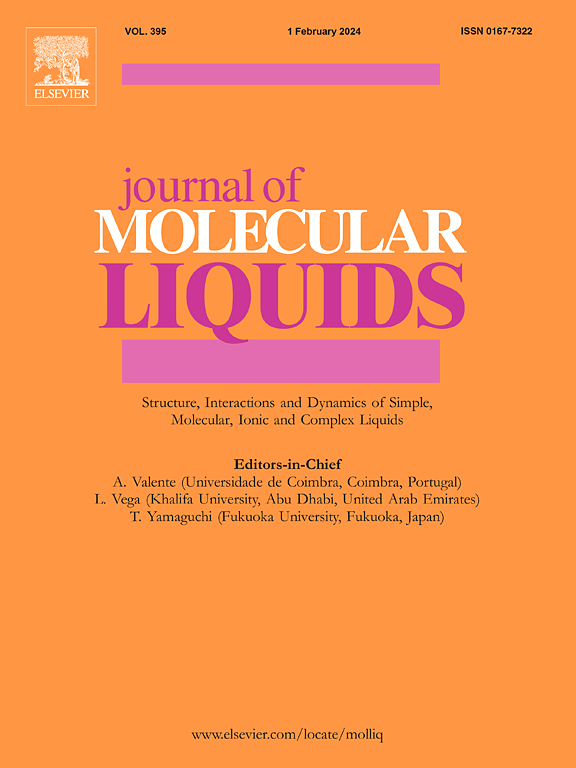Performance of delaying release and reducing adsorption of polyethyleneimine/poly(vinyl sulfonate) polyelectrolyte complex nanoparticles in polyacrylamide/polyethyleneimine gel system
IF 5.3
2区 化学
Q2 CHEMISTRY, PHYSICAL
引用次数: 0
Abstract
Polyacrylamide/Polyethyleneimine (HPAM/PEI) is an environmentally friendly and promising gel system. However, inadequate gelation time and retention of the cross-linker (polyethyleneimine, PEI) during migration pose significant challenges for effective water control treatment in deep reservoirs. Polyelectrolyte complex nanoparticles (PECs) have demonstrated the ability to efficiently encapsulate PEI, facilitating for its gradual release. To achieve this, a cost-effective polyanionic complex, poly(vinyl sulfonate) (PVS), was employed to form PECs with PEI. By adjusting the mixing ratio of PEI and PVS, stable PECs suspensions with varying charges were successfully produced. These stable PECs exhibited spherical shapes with a particle size distribution ranging from 127.3–442.71 nm, and an average particle size of approximately 200 nm. The encapsulation efficiency of PEI by PECs varied from 64.56 % to 86.14 %. Under different conditions, 55.12 % to 90.26 % of PEI could be released from PECs. Increased temperatures, higher ionic strengths, and greater deviations in pH from the initial state of the PECs suspension all facilitated the release of PEI. The most stable PECs delayed the gelation time of the HPAM/PEI system to 9.5 days, which is twice the base gelation time of 4.5 days. The strength of mature HPAM/PEI (PECs) gels increased by 8.95 Pa in storage modulus (G′) compared to HPAM/PEI at the same concentration, albeit with a reduced linear viscoelastic region. And, the PECs-based delayed crosslinking method does not negatively affect the mechanical strength of the HPAM/PEI gel system, and thus its water control ability, under reservoir conditions. On the other hand, the static adsorption of PEI encapsulated by anionic PECs on sand decreased to one-fourth of that of free PEI (PEI solution). Additionally, the breakthrough of PEI encapsulated in anionic PECs in fractured sandstone cores was significantly advanced compared to free PEI.
聚乙烯亚胺/聚乙烯磺酸聚电解质复合物纳米颗粒在聚丙烯酰胺/聚乙烯亚胺凝胶体系中的延迟释放和减少吸附性能
聚丙烯酰胺/聚乙烯亚胺(HPAM/PEI)是一种环保且前景广阔的凝胶系统。然而,凝胶化时间不足和交联剂(聚乙烯亚胺,PEI)在迁移过程中的滞留给深层水库的有效控水处理带来了巨大挑战。聚电解质复合纳米粒子(PECs)已证明能够有效地包裹 PEI,从而促进其逐步释放。为此,我们采用了一种经济高效的聚阴离子复合物--聚(乙烯基磺酸)(PVS)来与 PEI 形成 PECs。通过调整 PEI 和 PVS 的混合比例,成功制备出了具有不同电荷的稳定 PECs 悬浮液。这些稳定的 PEC 呈球形,粒径分布范围为 127.3-442.71 nm,平均粒径约为 200 nm。PECs 对 PEI 的封装效率从 64.56 % 到 86.14 % 不等。在不同条件下,55.12% 至 90.26% 的 PEI 可从 PECs 中释放出来。温度升高、离子强度增大、pH 值与 PECs 悬浮液初始状态的偏差增大都会促进 PEI 的释放。最稳定的 PEC 将 HPAM/PEI 系统的凝胶时间延迟到 9.5 天,是基础凝胶时间 4.5 天的两倍。与相同浓度的 HPAM/PEI 相比,成熟 HPAM/PEI (PECs)凝胶的存储模量(G′)增加了 8.95 Pa,但线性粘弹性区域有所减小。而且,基于 PECs 的延迟交联方法不会对 HPAM/PEI 凝胶体系的机械强度产生负面影响,因此也不会影响其在储层条件下的控水能力。另一方面,阴离子 PECs 包裹的 PEI 在沙子上的静态吸附量减少到游离 PEI(PEI 溶液)的四分之一。此外,与游离 PEI 相比,阴离子 PEC 包裹的 PEI 在裂缝砂岩岩心中的突破时间明显提前。
本文章由计算机程序翻译,如有差异,请以英文原文为准。
求助全文
约1分钟内获得全文
求助全文
来源期刊

Journal of Molecular Liquids
化学-物理:原子、分子和化学物理
CiteScore
10.30
自引率
16.70%
发文量
2597
审稿时长
78 days
期刊介绍:
The journal includes papers in the following areas:
– Simple organic liquids and mixtures
– Ionic liquids
– Surfactant solutions (including micelles and vesicles) and liquid interfaces
– Colloidal solutions and nanoparticles
– Thermotropic and lyotropic liquid crystals
– Ferrofluids
– Water, aqueous solutions and other hydrogen-bonded liquids
– Lubricants, polymer solutions and melts
– Molten metals and salts
– Phase transitions and critical phenomena in liquids and confined fluids
– Self assembly in complex liquids.– Biomolecules in solution
The emphasis is on the molecular (or microscopic) understanding of particular liquids or liquid systems, especially concerning structure, dynamics and intermolecular forces. The experimental techniques used may include:
– Conventional spectroscopy (mid-IR and far-IR, Raman, NMR, etc.)
– Non-linear optics and time resolved spectroscopy (psec, fsec, asec, ISRS, etc.)
– Light scattering (Rayleigh, Brillouin, PCS, etc.)
– Dielectric relaxation
– X-ray and neutron scattering and diffraction.
Experimental studies, computer simulations (MD or MC) and analytical theory will be considered for publication; papers just reporting experimental results that do not contribute to the understanding of the fundamentals of molecular and ionic liquids will not be accepted. Only papers of a non-routine nature and advancing the field will be considered for publication.
 求助内容:
求助内容: 应助结果提醒方式:
应助结果提醒方式:


